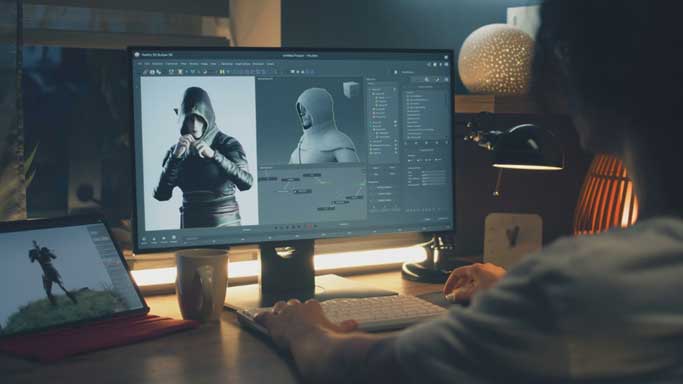When a player begins a video game, the game’s visuals are used by developers to hook them into the gaming world immediately. The art style that you choose is important not just for how the game looks but also for how players connect emotionally to the world, the characters, and the story. This is a key design decision that is made by considering the target audience, the story themes, and the gameplay you are targeting. Here is a look at some of the prominent art styles in games and how they affect game development and player experience.
The role of art in game design
The art style is one of the most important factors in a player’s first experience with a game. Visually, a game can either be realistic or lean toward a more stylized look, and these visuals can be enough to get players to take a closer look at the game. Art is also important for emotion, storytelling, and immersion, as well as aesthetics. For example, using more realistic imagery with darker tones in a horror game creates tension and fear, whereas bright, cartoonish visuals in a lighter genre can make it feel like a light and adventurous game.
Furthermore, when developing the art style, developers need to consider the game’s performance. Since highly detailed, realistic environments can strain system resources, it is important to find a way to optimize how detailed and realistic the environments can be. A game’s art style can also influence its marketability and how its community receives it. A striking art style can help a game stand out in a crowded marketplace and become iconic, such as the cel-shaded design in The Legend of Zelda: Breath of the Wild.
How art choices reflect game identity and audience
Game genres and target audiences are often closely related to art styles. For example, fantasy and adventure games lean toward the use of vibrant and colorful palettes because they represent magic and immersive worlds. Horror games, in contrast, tend to be darker in tone and realism, using imagery that is scarier and more suspenseful.
Game branding is also influenced by art style, which can extend to promoting the game’s long-term success. Usually, when a game has a unique style, its loyal fanbase will stay with it for a long time, and the community will keep bringing up the game for years to come. Such visually appealing designs are being used in the world of iGaming, and top real cash casinos are using them as well. Similarly, visual appeal is important in iGaming, as it is in traditional video games, to add to the atmosphere. Trusted sources such as OddsChecker offer information for those seeking gaming experiences and aesthetics.
Popular game art styles in modern gaming
Modern games use a variety of art styles to convey a particular style, and each has its own pros and cons. For example, The Last of Us is an example of a game that tries to bring realism in the sense that it attempts to replicate real-world visuals while providing users with the most lifelike experience possible. The level of detail they achieve is impressive, but it takes a lot of development resources to get there, and lower-quality hardware may struggle to keep up.
Cel-shading, on the other hand, paints games in bold outlines and flat colors for the illusion of a stylized, cartoonish nature. Many iconic titles have used this art style to support other elements of the game’s visuals, and it has the benefit of being hardware-friendly. Pixel art, or games with pixels, is another popular style, especially in indie games. It can create nostalgia without being overly resource-intensive, enabling smaller studios to make interesting games without investing in expensive graphics.
Art styles help games stand out
The modern art styles used in gaming are not just about aesthetics but part of defining and selling a game. The right art style can help a game stand out from its competition in the market, aid in developing an emotional bond with players, and create a game that is not likely to be forgotten. As technology progresses, developers will be presented with more options to build engaging games that look and feel spectacular.







